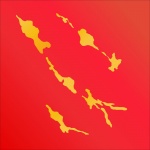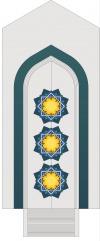Featured Article
|
The southern land of the continent of Pytharniaca is usually called Pytharnia, leaving the scientific term 'Pytharniaca' to those who wish to refer strictly to the whole land mass. In its commonly used sense, Pytharnia refers to the southern half settled by humans. In origin, Pytharnia originally meant the hilly lands between the Mathgefrew Mountains of the south and the dense woodlands of the north. The core territory of the Empire of Magdala or 'The Magdalanate' rests on the Pytharnian Highlands. Scholars do not have a wide consensus on the origin of the name 'Pytharnia.' Some believe it originates from the name of ancient dragons.
Pytharnia in its broadest geographic sense as Pytharniaca is a subcontinent that has been slowly merging into the much greater continent of Asdauria for eons, forming the world-famous Jaggudorns, the highest mountains in the known world and probably the whole world. Riddled with ancient tribes and languages, Pytharnia is home to humans, elves, dwarves, halflings, gnomes, beastmen, trolls, and many more creatures. Nestled in the high foothills of the southwestern Jaggudorns are found four dwarven states. The Amandal Plateau is home to another dwarven state, Amandalia, where mystical dwarves have communed with the infinite for eternity. Sardeichs is the smallest and the most economically driven of these dwarven micro-empires. Although this smallest of the dwarven states is well in the Jaggudorns, its commerce and outlook is towards Pytharnia and the Pallathantic Sea. (Full Article...)
|
Did you know...
|
- Did you know that the Jaggudorn Mountains are roughly the same elevation as the Himalayas but lie farther north and were the homeland of the ancient Sky Tribes?
- Did you know that the word Thrake originally meant a person of Thracian ancestry but came to be a term of disparagement for foreign rulers?
|
|
|
Featured Pictures
|
 Artist's depiction of the color produced by the dye ImridsulImridsul is a very costly dye made from the eggs of the deepearth-dwelling Thrystonese basilisk through a process that requires nearly two years (about 28 common months). The color imridsul is an intense crimson with brilliant streaks and splotches that sparkle like metallic gold. Garments made from cloths dyed this color are some of the most desirable in the world. The dye is extraordinarily color fast and does not fade even after many years. The effect is considered impossible to duplicate, but has stimulated a market for gold-embroidered crimson clothes which although costly are not as fantastically costly as cloths dyed in imridsul. In ancient times, the sale and use of the dye was strictly regulated by kings and its use reserved for aristocrats and royals. Even a small component of one's costume dyed in imridsul was a strong status symbol. (Full Article...)
 Yophenthean Gates of the Walls of TrevirsThe Yophenthean Gates of the Walls of Trevirs are over two thousand years old. Trevirs is the most populous human city in the Pallathantic Region with 960,000 inhabitants, the fourth most populous in the old world, and heir to a past reaching back into the mists of human history. Trevirs rests atop a large prominence of hills in the Magdanalate of the Empire of Magdala. The Palace of the Imperial Diet rests in Trevirs. Historically, Trevirs was also the place of the Imperial Palace. The city is sometimes called Great Trevirs to distinguish it expressly from Royal Trevirs. Trevirs arose in very ancient times as a Pytharnian Giant settlement and eventually came under control of various human tribes. Since the Fall of the Yophenthean Empire, Trevirs has served as an important skyport between the western Jaggudorns, Medibgö, and the Pallathantic Region. Trevirs is the financial capital of southeastern Pytharnia and the seat of the headquarters of several important organizations including the Dwarven Dragonrail Guild of Pytharnia and the Sovereign Archguild of Master Titancrafters of Pytharnia. Trevirs remains the seat of the Palace of the Imperial Diet of Magdala. (Full Article...)
|
Recommended Articles
These articles are recommended for gaining a better understanding of the history and background of the world of Asdar.
|
|
|